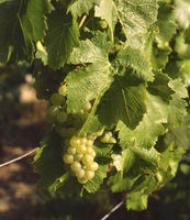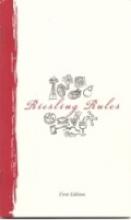Washington's Pacific Rim winery had its start in 1992, when Randall Grahm of California parent winery Bonny Doon first released a Bonny Doon dry Riesling under the label of Pacific Rim Dry Riesling. The wine was quite popular; there weren't a lot of California wineries offering a Riesling, and the success, and Grahm's personal love of Riesling, led to the spin-off of Pacific Rim as a separate winery. As the Web site says, "in August of 2006 a small band of Bonny Doon expats moved to the Northwest from California with a common desire to craft the best Riesling in America" and Pacific Rim the winery was born, with Nicolas Quillé, former Bonny Doon general manager and a winemaker himself serving as midwife.
Grahm has made his interest in biodynamics very clear, and Pacific Rim has continued to display an interest in biodynamic wine making, as well as sustainable wine production. One of the things I like about the way they do this is that they're very matter-of-fact and direct about it; there's not a lot of holier than thou flag waving; they're still primarily interested in making good wine, and they see overlap in biodynamic production, and sustainable methods. They only use stainless steel tanks for their Riesling, instead of, say, oak barrels. Their somewhat controversial but very ecology and customer-friendly decision to use aluminum screw caps on all their wines, as well as light-weight recyclable glass bottles, are instances of Pacific Rim of actually doing something about sustainability, rather than merely talking about it.
Pacific Rim is absolutely serious in their "Riesling zealotry." Indeed they have an official Riesling Manifesto in the form of the little Riesling Rules booklet. Pacific Rim sees Riesling as especially interesting because of the grape's potential for reflecting the terroir of the vineyard. Pacific Rim makes a suite of Rieslings, including Dry Riesling, Sweet Riesling, an organic Riesling, and a sparkling Riesling. So far the Pacific Rim Dry Riesling is the only one I've tried, and it was pretty amazing. Very definitely dry, not "sort of dry," as some Washington dry Rieslings are, but still fruity, fragrant, and with a definite citrus edge. It was truly marvelous, and one of those Rieslings that, while lovely on its own, does something remarkable when paired with food. I'm very much looking forward to trying the Gewürtztraminer, and the sparkling Riesling, but I notice that just this spring, Pacific Rim has started offering two wine blends under the Pacific Rim Autumnus label. Autumnus White is a blend of Washington varietals; Riesling, Chenin Blanc and Gewürztraminer. And, much to the shock of many, Pacific Rim is also offering a companion Autumnus Red, a blend Sangiovese, Barbera and Primitivo. I've been watching for both Autumnus wines locally, but as yet have not spotted either. I've also been watching for Pacific Rim's Framboise; it's a dessert wine, made with Morrison raspberries grown for Pacific Rim from a single Mount Vernon Washington farm. I can imagine all sorts of lovely ways to use it not only on its own, but in dessert. Think of an intensely rich Raspberry wine as a base for a sauce or chocolate cake filling.
Aside from an occasional reference to avoiding malolactic conversion, or the sugar content of their wines—an indication of the wine geek interests of Pacific Rim, their Web site is refreshingly honest and enthusiastic about their wines. Their descriptions are about the wines, and are straightforward and understandable. Take this one for their Chenin Blanc:
Our Chenin Blanc grapes come from the Columbia Valley. We produce only a small number of cases of this delicious white wine. Grape sourcing is limited, but this wine is simply too good not to make. The juice is fermented in stainless steel tanks (No oak, no malolactic) and we usually work toward 1.2% of Residual Sugar to balance the slight natural bitterness of Chenin (look for the grapefruit rind finish).
The wine is vividly bright with flavors of pear, quince and grapefruit essence with an eruption of floral aromas. An inspired complement to shellfish, grilled fish, soft cheeses and Middle Eastern food.
I confess, I have not, to the best of my knowledge, tried a Chenin Blanc; California still is the land of Chardonnay. But by golly, that description makes me want to try Pacific Rim's Chenin Blanc—if I can find it locally, which, so far, hasn't been possible. The Chenin Blanc, like most of the Pacific Rim wines retails for around $11.00, Pacific Rim also offers a collection of single vineyard varietals that run around $20.00 a bottle, including a Riesling from Wallula Valley grapes, Biodynamic Riesling from the Wallula vineyard in the Horse Heaven Hills of the Columbia Valley, Solstice Riesling and Dauenhauer Riesling using grapes from the Willamette Valley. These are serious efforts at utilizing the concept of terroir with Washington grown grapes, and then making decisions about the wine based on the unique qualities that the land offers the grapes, utilizing special irrigation, trellising, and harvesting by hand. They also make a Selenium Vineyard Vin De Glaciere Riesling, using grapes grown in Washington's Yakima Valley, picked carefully at a specific degree of ripeness and natural sugar, then frozen. The grapes are pressed while frozen, thus concentrating the natural sugars and creating what by all accounts (numerous medals) is an incredible eiswein style dessert wine.
A few months ago, in April, Forbes ran a blind taste-test comparing the Pacific Rim Riesling to Pacific Rim's more expensive single vineyard Wallula Valley Riesling. There's an article here, and it's actually quite interesting. A group of experts compared a series of regular and reserve wines in paris, using wines from the same winery for each pairing. Overall, the panel (experienced wine professionals all) seem to favor the less expensive Pacific Rim Dry Riesling. You can see the video for yourself.




